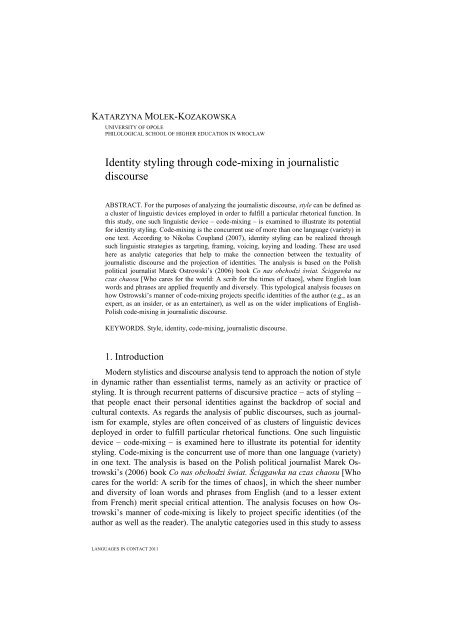s - Wyższa SzkoÅa Filologiczna we WrocÅawiu
s - Wyższa SzkoÅa Filologiczna we WrocÅawiu
s - Wyższa SzkoÅa Filologiczna we WrocÅawiu
Create successful ePaper yourself
Turn your PDF publications into a flip-book with our unique Google optimized e-Paper software.
KATARZYNA MOLEK-KOZAKOWSKA<br />
UNIVERSITY OF OPOLE<br />
PHILOLOGICAL SCHOOL OF HIGHER EDUCATION IN WROCŁAW<br />
Identity styling through code-mixing in journalistic<br />
discourse<br />
ABSTRACT. For the purposes of analyzing the journalistic discourse, style can be defined as<br />
a cluster of linguistic devices employed in order to fulfill a particular rhetorical function. In<br />
this study, one such linguistic device – code-mixing – is examined to illustrate its potential<br />
for identity styling. Code-mixing is the concurrent use of more than one language (variety) in<br />
one text. According to Nikolas Coupland (2007), identity styling can be realized through<br />
such linguistic strategies as targeting, framing, voicing, keying and loading. These are used<br />
here as analytic categories that help to make the connection bet<strong>we</strong>en the textuality of<br />
journalistic discourse and the projection of identities. The analysis is based on the Polish<br />
political journalist Marek Ostrowski’s (2006) book Co nas obchodzi świat. Ściągawka na<br />
czas chaosu [Who cares for the world: A scrib for the times of chaos], where English loan<br />
words and phrases are applied frequently and diversely. This typological analysis focuses on<br />
how Ostrowski’s manner of code-mixing projects specific identities of the author (e.g., as an<br />
expert, as an insider, or as an entertainer), as <strong>we</strong>ll as on the wider implications of English-<br />
Polish code-mixing in journalistic discourse.<br />
KEYWORDS. Style, identity, code-mixing, journalistic discourse.<br />
1. Introduction<br />
Modern stylistics and discourse analysis tend to approach the notion of style<br />
in dynamic rather than essentialist terms, namely as an activity or practice of<br />
styling. It is through recurrent patterns of discursive practice – acts of styling –<br />
that people enact their personal identities against the backdrop of social and<br />
cultural contexts. As regards the analysis of public discourses, such as journalism<br />
for example, styles are often conceived of as clusters of linguistic devices<br />
deployed in order to fulfill particular rhetorical functions. One such linguistic<br />
device – code-mixing – is examined here to illustrate its potential for identity<br />
styling. Code-mixing is the concurrent use of more than one language (variety)<br />
in one text. The analysis is based on the Polish political journalist Marek Ostrowski’s<br />
(2006) book Co nas obchodzi świat. Ściągawka na czas chaosu [Who<br />
cares for the world: A scrib for the times of chaos], in which the sheer number<br />
and diversity of loan words and phrases from English (and to a lesser extent<br />
from French) merit special critical attention. The analysis focuses on how Ostrowski’s<br />
manner of code-mixing is likely to project specific identities (of the<br />
author as <strong>we</strong>ll as the reader). The analytic categories used in this study to assess<br />
LANGUAGES IN CONTACT 2011
















